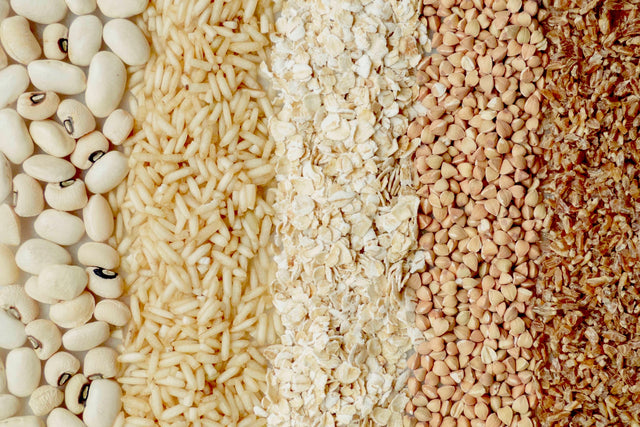While you might be able to stack a couple plates and plow through reps on leg day, a competition, or through your WOD, that doesn’t necessarily mean that your body is ready perform them at your highest potential. Keep reading to find out our 9 crucial squat tips to improve form, strength and size so you can be the best athlete you can be.
The Importance Of Mobility And Stability
Our bodies are incredible at creating an entire orchestra of muscle contractions influenced and controlled by the information being sent to and from the central nervous system (CNS). This information helps our joints create the actions needed to accomplish various tasks, such as squatting.
- Mobility: the ability to move freely and easily
- Stability: the ability to maintain proper posture and support during movement
When mobility and stability are overlooked the wheels fall off the squat one by one. An athlete can create movement dysfunctions resulting in injury, chronic pattern overload, malalignments in the joints and/or bones, as well as muscular imbalances. All of this results from a loss of stability and mobility. The squat tips that we talk about in this article are designed to help you improve mobility, stability, and overall strength in the squat movement. After all, the squat is one of the best bodyweight exercises for stronger glutes (learn about the other ones here).

Squat Tips - Core Bracing
If I walked up to you and punched you in the stomach, would my hand break, or would your stomach? If you answered the latter, you probably don’t brace your core to support your body during the squat movement. Squat tip? Brace the core. If you collapse forward during the squat or are seeing a strong anterior pelvic tilt, you need to work on your breathing while isometrically coordinating the anterior and posterior torso stabilizers.
Doing so will keep you upright, stable, and tense, generating more power and strength through your entire squat movement. Don’t neglect full body core work and practicing various breathing techniques (click here to learn more about breathing while lifting). Learning that intramuscular coordination and contraction will improving your core bracing abilities and you’ll finally see that PR come into the light.
IN SUMMARY: Keep the core tight and brace the spine. Do this by squeezing the muscles, breathing properly, and don’t relax in the bottom of the squat. Pull the elbows down, create space for the lungs, brace the core, squeeze the glutes… it all begins coming together.
Squat Tips - Rounding The Back
Rounding out the back when squatting? Ask yourself if the weight is too heavy or if your hips and hamstrings are too tight and immobile to support the kinetic chain and squat load. You could also look into upper back strength and if the volume is too demanding. If you’re looking to improve your squat depth, it starts with dynamic stretches prior to even touching the barbell. If you’re looking to create more tension and get a grip on your squat form, key in accessory movements that incorporate pulling, pushing, and shoulder mobility. If back squats are giving you trouble, another squat variation are front squats. Click here and check out this quick guide on how to do them properly.
IN SUMMARY: Don’t squat like a dick. If you’re chasing a big squat and your back is rounding, put the barbell down and focus on systemic strength, mobility, and stability under tension.
Squat Tips - Avoid Knee Caving
Sometimes the knees cave from a technique issue, other times it happens due to some serious weaknesses in the hip abductors. Thinking to yourself “push the knees out” can help some people, while others it comes down to the mind muscle connection, activating the glutes from the moment you unrack the barbell. Have this problem? Practice glute activation by doing some lateral side-to-side walks or x-band walks. Another way to help this is by reaching town, holding your toes with your hands, and squatting down with an emphasis on the knees driving out. Still having trouble? Get our 6-week “Glute Gains” workout program by clicking here.
IN SUMMARY: If the knees are caving, go back to the basics and work on accessory movements to strengthen the glutes. Also, stop squatting in running shoes, that’s a great squat tip.

Squat Tips - Get Tight Before You Unrack
Most people just grab the bar, put it on their shoulders, take 6 steps back away from the rig, wobble around, then squat. WRONG. If you don’t get your body primed and tight, ready to receive the land before you unpack, you’re missing the first opportunity to set yourself up for success. Not getting so sets you up for injuries, poor performance, and missed lifts. Yikes.
Here’s what you do instead, ok? Get tight under the bar with your whole body, including your hands. Create a shelf for the bar to sit, engage the lats, pull the shoulder blades in, and contract your abs like someone is going to sock you in the stomach. Then? Stand up with the weight at the rig, take one step back, then take another step back into your squat. Prime, then lower.
IN SUMMARY: Don’t waste time, energy, or effort taking lots of steps or not bracing before you accept/unrack the weight. Cluster sets are a great way to practice this with lower weight.
Squat Tips - Get Familiar With Pause Squats/Eccentric Squats
With these bad boys, you’re not just going to get stronger physically, you’re going to get a whole lot stronger mentally, too. We’re not talking about dropping into a quick squat, hanging out for a second, then hopping up. We’re talking about recruiting your sensory signals and proprioceptive feedback with purpose and intensity.
This is where the mind strength comes in. Not only are you focusing on proper mechanics and activation through the movement, you’re lowering at a slow and controlled tempo, staying tight and activated, while pausing for a count in the fully stretched position, paying attention to any and all somatosensory feedback.
Sounds like hell? It can feel like it for those 10 seconds for sure. BUT! Before you knock it, hear me out - the feedback your body gives your mind is crucial for growing. Squat tip 101 - listen to your body to fine-tune your squat patterns. These are called eccentric squats or pause squats. The gains are worth it. You can learn more about accessory movements like eccentrics to build a bigger back squat by clicking here.
IN SUMMARY: Eccentric/pause squats help you learn the necessary feedback from your body to improve your squat form. Think of it as your own way of providing yourself squat tips. Be sure to hit that full range of motion and fine-tune your movement with eccentric isometrics.

Squat Tips - Depth Matters
Athletes miss depth due to a few different reasons. Hip mobility, ankle mobility, knee injuries, glute weakness, and back muscle imbalances are all reasons why the kinetic chain is off. However, there are a few specific culprits that as trainers, we see all the time.
-
Hip Flexors:
Sit all day? Guilty. Don’t stretch? Guilty. Poor pelvic alignment and glute weakness? Yup, that too. Ready for the next squat tip? If you don’t help the hips with mobility, you can say good bye to stability. Try implementing glute bridges, rear foot elevated hip flexor stretches, as well as some striders to open them up. -
Unsupportive Footwear:
We’re talking heels, right footwear, and random activities like chasing your kids or shooting some hoops when you’re not warmed up. This is why you see people squatting with plates under their feet - it compensates for the lack of ankle mobility. Losing this mobility thanks to the shoes we wear won’t actually allow for the shins to move forward in the natural position as we lower into the squat. -
Poor Mind-Muscle Connection:
Other times it’s not your mobility, stability, or strength. It’s your mind not talking to your body, or listening to it. Think about activating the muscles as you use them and the parts of the body to improve the connection between the two.
IN SUMMARY: Your daily habits will keep you from your ultimate depth in the squat if you don’t address them. Practice the mind muscle connection for your squats in your warm up with exercises like glute bridges, strides, and ankle stretches.
Squat Tips - Activate The Glutes
From the moment you lift the barbell from the racks you should be making the connection with your glutes and ensuring that they’re firing off. Keeping this proprioception throughout the movement will ensure that they’re working for you, not against you. A back squat without active glutes sets you up for not only poor performance, full range of motion, and even injury.
Practice with your stance - does your body respond better with your feet at your shoulders or a little bit further? Try turning your toes to one and eleven and watch your glutes go wild. A wider stance will activate the posterior chain (glutes and hams) whereas a narrower stance will activate more of the quadriceps.
IN SUMMARY: There is no one size fits all for squat stance. Don’t just rely on the hip flexors to do the work of raising and lowering you - recruit the glutes and see your squat transform.

Squat Tips - Ankle Mobility
Back to the mobility argument, we’re focusing in specifically on the ankles. If the ankles aren’t moving, the rest of the kinetic chain and the whole squat is going to be off. The load can’t be distributed efficiently and if the ankles are pronating (not supinating), the hips won’t open up, the knees won’t move out to the side, and the whole thing is shot. Weak glutes, knees collapsing, flat feet or fallen arches? Then you’re at a higher risk for poor ankle mobility.
IN SUMMARY: Ankle mobility can be a major limiting factor for squat form. Need help with your ankle mobility - we can help you. Click here to read how in our ankle mobility guide from a professional sports therapist.
Squat Tips - Bar Positioning
This is going to come with trial and error. Look, here’s the truth - no two bodies are the same. Where the bar sits on me might not sit quite right on you and vis versa. Practice with both high and low bar positioning to see what works for you. Wondering what’s the difference between high bar and low bar squat? Check it out:- High-Bar Squats: high-bar squats sits higher on the traps and calls into play more of the quads with less dependence on the hamstrings for strength through the movement.
- Low-Bar Squats: the bar sits 2-4 inches below the high bar positioning and activates the posterior chain slightly more than high-bar. This means your hams, glutes, and lower back are going to be more involved as the hips sit back and the torso comes forward more.
IN SUMMARY: Which one is better? Well, the one that works for you. Play with them both and see which one delivers the best form for your body mechanics, stability, and mobility.
All in all, with these squat tips you’re going to be well on your way to improving your form, strength and size. Look, everyone has a little bit of a different squat which also means the movements and stretches you do before you lift are going to vary. While there are 9 killer tips in this article to help you, work on one at a time. Don’t overload the body or overcomplicate the movement. Don’t neglect your squat accessory work and stretching, set yourself up for success by simplifying your unpacking routine, and definitely don’t forget to take the BUILD STACK from Swolverine.
Muscle fatigue during high-intensity training is a real thing. But what if you could delay it and increase your repetitions, increase your endurance to clock faster times, get stronger and lift heavier, and even recover faster? You'd be able to compete at a higher level. Now that’s how you build a bigger squat.
CLICK THE IMAGE TO LEARN MORE ABOUT THIS CLINICALLY PROVEN SUPPLEMENT STACK
SWOLVERINE IS AN ENDURANCE ATHLETE AND ACTIVE LIFESTYLE BRAND. MADE FOR THE ELITE ATHLETE, AND THE STRONG-WILLED OUR PRODUCTS WERE DESIGNED TO FUEL YOUR ATHLETIC PERFORMANCE. WE PERFORM WHEN YOU PERFORM.
We believe that everyone can optimize not only their athletic performance but their human potential. The way we believe we can optimize performance is through transparency, clinically effective doses, and clinically proven ingredients with evidence-based outcomes. We provide the nutrients you need to power your active lifestyle.








